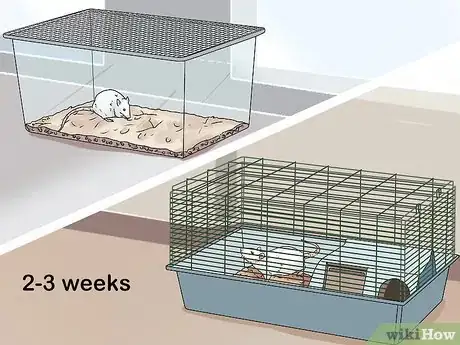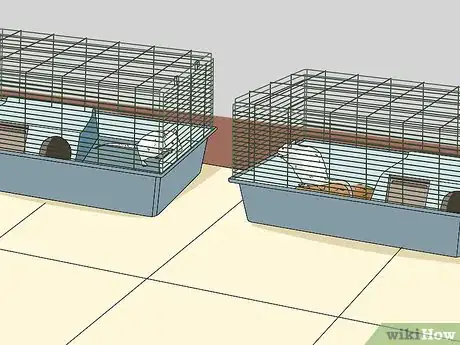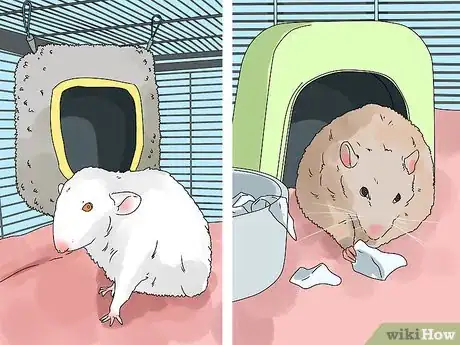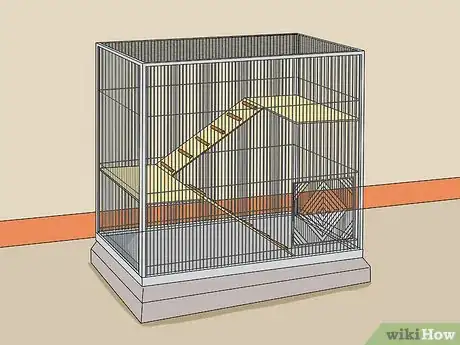This article was co-authored by Brian Starr. Brian Starr is a Rat Specialist and Breeder and the Owner of OC Dumbos out of Central Florida. As America’s only breeder of pet Roof Rats, Brian and OC Dumbos specialize in rat breeding, training, and care. Years of experience and several generations of careful breeding have allowed Brian and OC Dumbos to create a line of tame Roof Rats, bred to make friendly, fun pets. In addition to offering rat accessories and training resources, OC Dumbos also offers free Roof Rat adoptions.
There are 7 references cited in this article, which can be found at the bottom of the page.
This article has been viewed 49,188 times.
Rats are very social creatures, so if you keep one as a pet, it will probably enjoy living with another rat. However, if 2 rats were not raised together from a young age, they may fight and be territorial with each other when they first meet.[1] Fortunately, by slowly introducing the rats to each other over time, you can make it much more likely that they’ll become best friends and even be able to live in the same cage together.
Steps
Introducing the Rats to Each Other’s Scent
-
1Quarantine your new rat in a separate location for 2-3 weeks. Before you introduce your rats to each other, you’ll want to make sure your new rat won’t pass on any diseases to your other rat. Keep the new rat in a separate room as far away from your other rat as possible for the first 2 weeks after you bring it home to keep your other rat safe.[2]
- If possible, quarantine your new rat by leaving it at the home of a friend or family member for maximum safety.
- To keep yourself safe, wash your hands in between handling your rats, as well.
-
2Place the cages next to each other for brief periods of time every day. This will allow the rats to see and smell each other before they meet “in person.” Maintain a healthy distance between the cages, between 1 and 3 feet (0.30 and 0.91 m), in order to keep the rats from biting or scratching each other. Do this for about 10-15 minutes twice a day for 4-7 days.[3]
- Placing the cages next to each other allows the rats to become accustomed to the sight and smell of each other without forcing them to interact too quickly.
- If the rats don’t show any signs of aggression or agitation, move the cages a little bit closer together. However, make sure the cages are always at least 6 inches (15 cm) apart from each other to keep the rats from being able to intentionally or accidentally harm each other.
- It's normal for your rats to be a little agitated at first, but if they are constantly very upset and aggressive (hissing, puffing up fur, etc.), move the cages farther apart for a while before moving them closer again.
- To make this interaction go smoother, you can also give each rat a treat when you put their cages next to each other.
Advertisement -
3Put a few things from each rat’s cage in the other’s cage. This will give each rat a chance to get better used to the other rat’s smell. Put a paper towel in each cage and then switch the towels the next day, or switch their hammocks, chew sticks, or water bottles. Do this during the latter half of the week in which you put their cages next to each other.[4]
- Make sure you only do this if the rats seem comfortable with seeing and smelling each other through the bars.
-
4Allow each rat to spend some time alone in the other’s cage. After you’ve gotten the rats used to each other’s scent, letting them spend time in each other’s cage will get them used to being in an entire environment marked by the other’s scent. Do this for 15-30 minutes at a time and repeat this 2-3 days.[5]
- For best results, do this switch experience after you’ve spent at least 4 days letting the rats get used to each other just by looking at each other through their cages.
- Note that some rats may just become insecure about being in another rat’s cage, so don’t worry if your rat seems agitated at first. Try again the next day.
Having the Rats Interact with Each Other
-
1Let the rats meet on “neutral ground” so they aren’t territorial. This neutral ground should be a place where neither of the rats has spent a lot of time, meaning neither of the rats will claim the territory as their own. Places such as on your lap, in a dry bathtub, or on a table will work.[6]
- Having the rats meet on neutral ground means that neither of them will feel like they have to defend their territory. This should help prevent any fighting between the rats when they first interact.
- Plan to keep this interaction short (roughly 15-30 minutes) at first, although feel free to let it go on longer if the rats seem to be getting along. Repeat the interaction for 2-3 days or longer if the rats don’t get along at first.
-
2Lay out rat treats in the neutral territory to make the rats happier. They will love fresh fruits and veggies, as well as unsalted nuts and seeds. Make sure there are plenty of treats for both of them so they won't feel threatened. This should be fun for them and help them start to see each other as friends.[7]
- They may not want to eat it at first. This is normal, they usually don't eat if they are in an uncomfortable situation. If they start to eat together, this is a sign that they are starting to trust each other!
- Before putting the rats together, make sure you have towels on hand to separate them with if they start to fight. You never want to stick your bare hand between 2 fighting animals.
-
3Allow the rats to engage in dominance behavior without fighting. When your rats first meet, you should expect them to do some light tumbling and wrestling, as this is how rats establish who’s “dominant.” However, if either of the rats starts squeaking a lot, or you see blood, squirt the rats with water while separating them to communicate that you don’t approve of them fighting.[8] [9]
- Keep the rats separated for a day and try having them interact again tomorrow.
- If the rats don’t get along, try holding the new rat in your lap to signal to the old rat that you like the new rat.
-
4Leave the rats to continue interacting for several hours if it goes well. If the rats don’t fight and the dominance behavior is minimal, feel free to allow their neutral territory meeting to go on for a few hours. This will allow them to bond even further, making it easier for them to eventually become cage buddies.[10]
-
5Have the rats meet every day for a week or until they get along well. You should have short meetings in neutral territory every day for at least week or until they have no problems interacting with each other. Keep the visits short and supervised, although you can make them longer if they get along well together.[11]
- Your goal should not only be for them to refrain from fighting with each other, but also not engage in any aggressive or dominance-asserting behavior with each other. You want them to essentially act like good friends before they move in together.
Moving the Rats into the Same Cage
-
1Make sure the cage contains at least 4 cubic feet (0.11 m3) of space. This is the minimum amount of space required for 2 rats living together. If you plan to house more than 2 rats in the same cage, increase the size of the cage by 2 cubic feet (0.057 m3) per extra rat.[12]
- For example, if you plan to house 3 rats in the same cage, the cage should provide 6 cubic feet (0.17 m3) of space.
-
2Clean and disinfect the cage if you’re reusing the old one. If one of the rats was using the cage before, you need to make it like a completely new cage for both it and the new rat. Use disinfecting soap and warm water to clean the inside of the cage. Then, set up the cage with new bedding, decorations, toys, and food.[13]
- The cage needs to be totally new and clean so that the rat you had in it before won't have lay any territorial claim to it.
- The cage should even look different. Put the litter box, shelves, and hammocks in different places from where they were before.
-
3Place both rats inside the cage in the morning. This is the best time of day to put both rats in the same cage, since they’ll most likely spend the first hours of the day sleeping instead of fighting. If possible, trim their nails before you place them in the cage to keep them from being able to scratch each other.[14]
-
4Allow the rats to squabble for the first few days. Rats are hierarchical, so this squabbling is normal for them to determine who will be the alpha rat. However, if you find they are aggressively fighting rather than gently wrestling, put the rats back in separate cages.[15]
- Hopefully your rats will have already learned to get along by this point, but there may still be some scrapping just to establish who’s the dominant rat in the cage.
- If the rats continue to fight for several weeks, keep them in separate cages permanently, as they won’t be able to peacefully share the same cage.
Expert Q&A
-
QuestionHow do you introduce a new rat to a pair?
 Brian StarrBrian Starr is a Rat Specialist and Breeder and the Owner of OC Dumbos out of Central Florida. As America’s only breeder of pet Roof Rats, Brian and OC Dumbos specialize in rat breeding, training, and care. Years of experience and several generations of careful breeding have allowed Brian and OC Dumbos to create a line of tame Roof Rats, bred to make friendly, fun pets. In addition to offering rat accessories and training resources, OC Dumbos also offers free Roof Rat adoptions.
Brian StarrBrian Starr is a Rat Specialist and Breeder and the Owner of OC Dumbos out of Central Florida. As America’s only breeder of pet Roof Rats, Brian and OC Dumbos specialize in rat breeding, training, and care. Years of experience and several generations of careful breeding have allowed Brian and OC Dumbos to create a line of tame Roof Rats, bred to make friendly, fun pets. In addition to offering rat accessories and training resources, OC Dumbos also offers free Roof Rat adoptions.
Rat Specialist & Breeder Try rubbing something strong-smelling on the new rat's stomach, like vanilla. Other rats usually like that smell.
Try rubbing something strong-smelling on the new rat's stomach, like vanilla. Other rats usually like that smell. -
QuestionHow can I break up a fight between two rats?
 Brian StarrBrian Starr is a Rat Specialist and Breeder and the Owner of OC Dumbos out of Central Florida. As America’s only breeder of pet Roof Rats, Brian and OC Dumbos specialize in rat breeding, training, and care. Years of experience and several generations of careful breeding have allowed Brian and OC Dumbos to create a line of tame Roof Rats, bred to make friendly, fun pets. In addition to offering rat accessories and training resources, OC Dumbos also offers free Roof Rat adoptions.
Brian StarrBrian Starr is a Rat Specialist and Breeder and the Owner of OC Dumbos out of Central Florida. As America’s only breeder of pet Roof Rats, Brian and OC Dumbos specialize in rat breeding, training, and care. Years of experience and several generations of careful breeding have allowed Brian and OC Dumbos to create a line of tame Roof Rats, bred to make friendly, fun pets. In addition to offering rat accessories and training resources, OC Dumbos also offers free Roof Rat adoptions.
Rat Specialist & Breeder If you want to break up a fight, use a squirt bottle with water in it to squirt at the rat that's attacking the other rat. That will usually stop them.
If you want to break up a fight, use a squirt bottle with water in it to squirt at the rat that's attacking the other rat. That will usually stop them. -
QuestionIs it safe to introduce a young rat to an older rat?
 Brian StarrBrian Starr is a Rat Specialist and Breeder and the Owner of OC Dumbos out of Central Florida. As America’s only breeder of pet Roof Rats, Brian and OC Dumbos specialize in rat breeding, training, and care. Years of experience and several generations of careful breeding have allowed Brian and OC Dumbos to create a line of tame Roof Rats, bred to make friendly, fun pets. In addition to offering rat accessories and training resources, OC Dumbos also offers free Roof Rat adoptions.
Brian StarrBrian Starr is a Rat Specialist and Breeder and the Owner of OC Dumbos out of Central Florida. As America’s only breeder of pet Roof Rats, Brian and OC Dumbos specialize in rat breeding, training, and care. Years of experience and several generations of careful breeding have allowed Brian and OC Dumbos to create a line of tame Roof Rats, bred to make friendly, fun pets. In addition to offering rat accessories and training resources, OC Dumbos also offers free Roof Rat adoptions.
Rat Specialist & Breeder If you introduce a young female to an older female, you need to make sure that the young female is at least six to seven weeks old. Otherwise, a very small baby could be killed by the older female. This is something females sometimes do, and it can happen really quickly. As far as males, it depends on the young male rat. Usually, if you introduce a five, six, or seven week old male to an older male, the older male will accept them. They might chase them around for a while, and there might be some drama, but it will usually be fine.
If you introduce a young female to an older female, you need to make sure that the young female is at least six to seven weeks old. Otherwise, a very small baby could be killed by the older female. This is something females sometimes do, and it can happen really quickly. As far as males, it depends on the young male rat. Usually, if you introduce a five, six, or seven week old male to an older male, the older male will accept them. They might chase them around for a while, and there might be some drama, but it will usually be fine.
References
- ↑ Brian Starr. Rat Specialist & Breeder. Expert Interview. 18 March 2021.
- ↑ http://aboutpetrats.com/pet-rat-introductions.html
- ↑ http://www.ratfanclub.org/newrat.html
- ↑ http://ratclub.org/ratcare_intros.htm
- ↑ http://www.rmca.org/Resources/aintro.txt
- ↑ http://ratguide.com/care/behavior/introducing_rats.php
- ↑ http://ratguide.com/care/behavior/introducing_rats.php
- ↑ http://www.ratfanclub.org/newrat.html
- ↑ Brian Starr. Rat Specialist & Breeder. Expert Interview. 18 March 2021.
About This Article
To introduce a new pet rat to another rat, keep them separated in different cages for 2-3 weeks. Then, put the cages right next to each other for 10-15 minutes twice a day for 4-7 days so they can get used to the sight and scent of each other. Next, allow each rat to spend some time alone in the other’s cage for 15-30 minutes at a time for 2-3 days. Finally, let the rats meet on neutral ground, like a tabletop or dry bathtub. For more advice from our Veterinary co-author, like how to get the rats to live in the same cage, read on!









































































